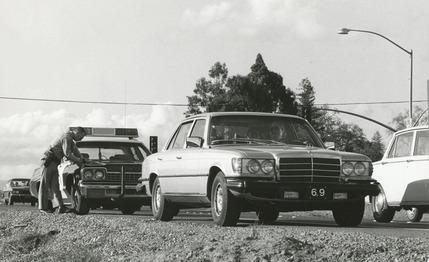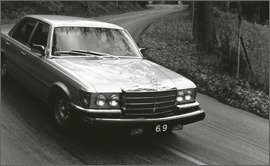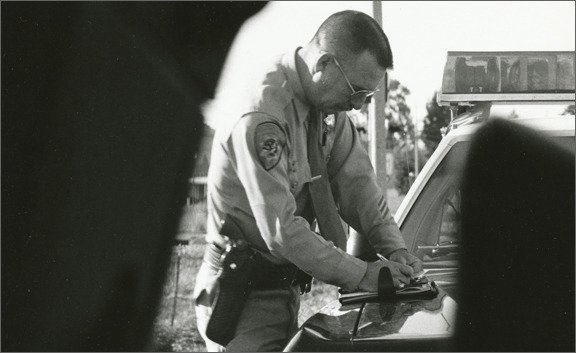
 Archived Road Test
Archived Road Test




Five-hundred Americans will fork over a total of $19,500,000 for the pleasure of owning Mercedes-Benz 450SEL 6.9s in the next twelve months and, presumably, each year thereafter, until Mr. Carter or his successor puts a stop to all such automotive hedonism. Except for the vagaries of international monetary fluctuations, the 6.9 might have made it to this country for $23,000 or so, but inflation, the strength of the Deutsche mark and the relative weakness of the dollar and everything else have combined to dictate that your own personal 6.9 sedan will cost you $38,230 f.o.b. New York. For your money, you’ll get, perhaps, the ultimate manifestation of the basic Daimler-Benz idea of how automobiles are supposed to be designed and built—the best Mercedes-Benz automobile ever sold.
That does not necessarily make it the best car in the world; not even the most luxurious. We have to call anything that has wheels and seats and a price of $40,000 a luxury car, but this Mercedes doesn’t offer a great deal of luxury for that kind of money. It is virtually indistinguishable from any other 450SEL, except for the 6.9 emblem and the wider wheels and tires, and there are no important interior clues, other than a strip of wood across the fascia, to set it apart from any other Mercedes-Benz. If I spent almost 40 grand for an automobile, I’m not sure I’d want it to look just like my neighbor’s 280S.
Be that as it may, however, and perhaps it never was, there was no speculation whatsoever involved in Daimler-Benz’s decision to market the 6.9 in America. The car is here because there was sufficient outcry from American dealers and customers to practically force the factory to import it, even though it can’t build enough for the European market where the car has been on sale for eighteen months. At a rate of 500 cars per annum, they’ll be sold as fast as they can get them off the boat and remove the cosmoline.


Who’ll buy it? Two kinds of people: first, those poor, bored, big spenders who’d already bought one of each Mercedes-Benz currently available and who were beginning to suffer the pangs of withdrawal because there were no still more expensive ones left to purchase; and second, that tiny handful of people, many of them former owners of Mercedes-Benz 6.3 sedans, who truly want the fastest production four-door sedan in the world and are willing to pay for it. Both groups will get their money’s worth. Anybody else who accidentally stumbles into his friendly neighborhood Mercedes-Benz dealer’s show-room with $40,000 burning a hole in his pocket is apt to be disappointed. This is no Rolls-Royce. There is no evidence of handcrafted attention to your every whim. It has wood and leather, but somehow these materials have been so impregnated, protected and depersonalized as to seem no different from the plastic materials they replace. The inside of a Rolls-Royce, for the same money, fairly reeks of wood, leather and loving care. The 6.9 seems to want to rub your nose in the fiction that it’s just another off-the-shelf Mercedes-Benz that only happens to go through corners like it was pursued by demons and cruise quietly all day long at 130—the most uncompromisingly spartan luxury car we’ve ever driven, a $40,000 technical exercise.
The 6.9 was destined to be more than a mere replacement for the 300SEL 6.3. (The 6.3 was the big news in 1968 when it was introduced. It was the 300SEL body with air suspension and a hot-rodded version of the 600 limousine’s engine and it went like the clappers. A total of 1840 were sold before Daimler-Benz stopped producing the car in 1971, but the 6.3’s impact on enthusiasts far exceeded its sales.) The 6.9 is meant to be the flagship of the entire Mercedes-Benz fleet. Beneath the surface there are all kinds of fascinating bits of technica curiosa. A dry-sump engine, for instance. Self-leveling hydropneumatic strut suspension, à la Citroën, for another. Specially modified three-speed automatic transmission, beefed up driveline and a very sophisticated Watts linkage applied to the already superior Mercedes independent rear suspension to enhance anti-dive and anti-squat performance on hard braking and acceleration.
How does it all work? Superbly. The 6.9 feels more nimble, more agile than any other Mercedes we can remember. The new suspension, combined with the extra power of the 417-cubic inch engine makes it possible to toss the big sedan around like a bug-eye Sprite. It accelerates 0–60 in a little over seven seconds and has a top speed of nearly 140 mph. It is rock-solid and practically silent on the road, at any speed, and the engine’s mind-range performance makes serious high-speed mountain driving a positive joy. Its predecessor, the 6.3, was a little crude, a little brutal in the way it went fast. The 6.9 is not quite so fast as the 6.3, but far silkier and more sophisticated. Additionally, it enjoys all the benefits of the 450SEL body—tightness, security, stiffness and aerodynamics that not only make the shape slippery but keep the windows clean as well.
Unfortunately, both the 6.3 and its sister flagship, the 600 limousine, were quirky, troublesome cars to live with. At this point, dozens of happy 6.3 and 600 owners will take pens in hand to refute what I’ve just said, but I let the statement stand; they were difficult and expensive cars to maintain, whatever their other virtues, and one hopes that the 6.9 will behave better in this respect. Our initial experience was not reassuring on this point. On our cross-country voyage of discovery, we had to visit the dealer in Nashville—”Madison Smith, Naturally”—to make the air conditioning work, and the dealer in Williamsport, Pennsylvania—Fran Wylie Motors, Inc.—had to visit us in a Sunoco station on Interstate 80 when the lower pulley on the engine started to fall off, a mishap that would have cost us the services of both the auxiliary transmission pump and the air-conditioning compressor pump, as well as quite possibly fiending the radiator and other important items, had it completely unscrewed itself.

